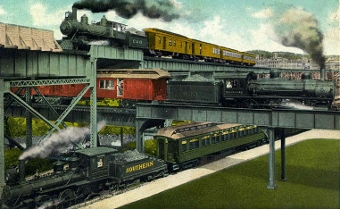Crossroads
Every four years the American Society of Civil Engineers (ASCE) releases an infrastructure report card. It covers dams and bridges, roadways, railways: If it is infrastructure related, it’s probably covered.
In 2013 when the report hit the streets (the last such report released), roadways had only earned a grade of “D,” a slight improvement from the “D-” score roads were given four years earlier. In ’13 at the time of the report card’s release, our highways suffered a congestion rate of 42 percent. Remember, this is all according to the ASCE.
To recap: Roadways received a grade of “D” and highways rated a 58 percent non-congestion rate. Railways, mind you, fared at least a grade level better.
So, what does a 58 percent non-congestion rate (or, conversely, a 42 percent congestion rate) mean, actually? If I understand the situation correctly, what it means is that for the amount of vehicle miles rolled off daily, 42 percent of that is under congested roadway conditions, while 58 percent, conversely, is under non-congested, free-flowing conditions, in other words.
Now, the impact this has on air is considerable. If we are to assume that 97 percent of all roadway travel is done in polluting vehicles, those 97 percent of an estimated 253 million automobiles and light- and heavy-duty trucks are daily adding to what is already poor air quality in many parts of the country, particularly in cities. Now, add in congestion and the problem is compounded even more.
Keeping track
Meanwhile, during America’s formative growth years, it was due in large part to the advancing of the railroads that interior cities were established (for port cities, often sailing vessels were their reason for being) and for getting around town, travel was limited to walking or hoofing it (by horse, mule or oxen-pulled wagon), initially, followed first by the trolley, next by the bicycle and eventually the horseless carriage. And, yes, to repeat an often cited expression, the rest is history.

Identifying what works
It is important to keep in mind that the transportation sector is the only one amongst all others where emissions from such are on the rise instead of being in decline.
It also is important to note that the past could very well dictate how we proceed going forward. From history, if you recall, at the pinnacle of American railway building in 1916, 254,000 route-miles of railway track were laid. Today, that figure has been chipped away to an approximate 140,000. Add in an estimated 60,000 miles of subway, surface and elevated urban-based rail trackage. Meanwhile, lane-miles of roadway, whether in tunnels, on bridges or at grade (on the surface) total a hefty 4 million. Four million roadway versus some 200,000 railway miles? That’s quite an imbalance. Just imagine the air impact if that imbalance wasn’t so pronounced. Hint: Far improved.
By the same token, what if railway infrastructure was much more heavily relied upon than what it is at present? If this were the case, might we not see tremendous air-quality improvement especially if more and more of the trains operating on such ran on 100 percent renewably generated electricity as the California high-speed rail system is projected to do? Motor vehicles, too, could help, that is, if increasing numbers of those operating were to be like powered. True, but reaching a point where significant numbers of zero-emissions vehicles are occupying roadway space could be years off into the future, if it happens at all.
For its part, aviation’s carbon emissions’ concentration is four percent worldwide. Aviation could do much better and do way more. Ditto for watercraft. Make no mistake: There has been progress in this regard but, comparatively speaking, it’s been relatively slow going.
However, I think, at the end of the day, a much more balanced mobility-based platform is the key.
And, really, it all comes down to what we as traveling beings want, what we are willing to pay for and what is important to us.
Just to repeat: Being at one time, before the advent of the automobile, there was horse and buggy, wagons – covered, Conestoga or what-have-you; boats, ships and other water-borne vessels; trains, trolleys (streetcars) and interurban conveyances – all making use of rails to run on; bicycles; animals like horses, mules, oxen and more; as well as the old standby – the feet (any and all of the above working quite reliably I must say); at least these methods enabled us to get where we both wanted and needed to get to. But, it wasn’t only this. In terms of mode-type utilization, it was a much more leveled playing field.
Today, not so much. Just so you know, the game is skewed in favor of automobility; it is in this country, anyway.
Latest craze, all the rage
Speaking of which, there is a lot of buzz as of late in the area of autonomous automobility. Understandably so. Will this be the next generation in the grand scheme of private, personal automobility, that is, being provided a vehicle by which to move about and turning over all control to an artificially intelligent source of power? There are many who are banking on the technology being there to meet this, what now appears to be a daunting challenge.
It’s nice to have vision and to dream big. But, there is another construct that needs to be taken into consideration here, too – it’s called “practicality.”
All things considered
There is no question transportation is evolving. The real question: Is this evolution taking air quality into consideration? A little, first and foremost, or not at all?
– Alan Kandel
![320px-US_131,_M-6,_68th_St_interchange[1]](https://alankandel.scienceblog.com/files/2016/03/320px-US_131_M-6_68th_St_interchange1.jpg)
![Hydrogen_vehicle[1]](https://alankandel.scienceblog.com/files/2013/02/Hydrogen_vehicle1.jpg)
![NewOrleansHUDRedStreetcarRiverfrontCanal[1]](https://alankandel.scienceblog.com/files/2013/01/NewOrleansHUDRedStreetcarRiverfrontCanal1.jpg)